Lea Wait's Blog, page 14
May 14, 2025
Here’s to Getting Unstuck
Rob Kelley here, following Vaughn’s and Gabi’s posts this week and thinking about getting unstuck. I was stuck for the last several days on a book that continues to fight me. But I have a strategy, or at least a realization, that seems to reflect my writing reality more than my writing fantasy.
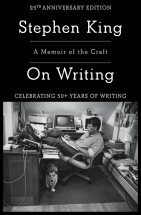 I’ve written before on the disconnect I have with how I thought this whole writing journey would all go and how it’s actually going. It’s not better, or worse, just different. In On Writing: A Memoir of the Craft, Stephen King says that he likes to get 2000 words in a day. That’s the classic “butt in chair” advice that often serves me well. Except on the days it doesn’t.
I’ve written before on the disconnect I have with how I thought this whole writing journey would all go and how it’s actually going. It’s not better, or worse, just different. In On Writing: A Memoir of the Craft, Stephen King says that he likes to get 2000 words in a day. That’s the classic “butt in chair” advice that often serves me well. Except on the days it doesn’t.
My partner, Margot Anne Kelley, writes both her nonfiction and (forthcoming!) fiction extremely deliberately. After months and months of research, she pours out words in a steady stream, not fast, but sure. That is so not me.
After a day in which I stare at the screen, or write then delete sentence after sentence, or just freak out and refuse to sit at the computer at all because my head is about to explode, Margot gently reminds me that I do not write like she does or like Stephen King does (though, wouldn’t that be nice?).
 I’ve come to think of the way I write as “burst mode.” I have a GoPro camera that I take along when we go on adventuresome travel. It’s hard while snorkeling to line up the perfect shot of a colorful fish below you, so I use the camera’s burst mode feature. It fires off a succession of multiple exposures. So, nothing, then a lot. That also seems to be the way I’ve come to write.
I’ve come to think of the way I write as “burst mode.” I have a GoPro camera that I take along when we go on adventuresome travel. It’s hard while snorkeling to line up the perfect shot of a colorful fish below you, so I use the camera’s burst mode feature. It fires off a succession of multiple exposures. So, nothing, then a lot. That also seems to be the way I’ve come to write.
I never go very long without a productive day. Sometimes a few days, sometimes a couple of weeks, before my writing anxiety is overwhelmed by my not-writing anxiety and things start to move.
Today I’m thinking about this because I’ve just been in several days of not writing. Events in the world and things in my own life have been distracting me, and I’m trying to gather up some of that grace that Margot shares with me, and give myself a break.
I’ve dreamed of writing and publishing a novel most of my life, since I was a kid sitting on my bed reading science fiction. Then life kind of got in the way and the creative energy needed to write a book got poured into building a company. But once I’d moved on to other things and my brain opened up some bandwidth for writing, I was raring to go.
But, like many writers, my writer’s self-image was this crazily outsized, overblown, fantastically inaccurate portrayal of what I’d experience. We all have read countless books on writing by writers we respect, looking for tips on how to make it all work better. Some work, some don’t.
The tip that matters for me today? Giving myself the grace to know that the focus will return, the words will come, the broken plotline will get fixed, the problematic character will be resolved.
In other words, today I am writing (and not just a blog entry!).
What works for you when you’re stuck?
May 13, 2025
On Being Stuck
I am stuck.
There.
I said it.
I am stuck. Stuck. Stuck.
It isn’t for wanting ideas. I absolutely drowning in some (possibly) brilliant ideas right now.
For example: a dystopian situation where a young girl is taken to an orphanage by a stranger, it’s unclear where all the other people are. It’s just her and this man. Her sister and parents have disappeared. At the orphanage two men let her in but then kill the stranger and take is body somewhere else. The next day, a family arrives. The father is dying. The two men let the boy in but turn away the father and mother, who is fine and very sad to let her son go. That’s the build up. But then what happens? Not sure. When I close my eyes, it’s like a twisted Wes Anderson movie.
Or this: A woman gets a call from her younger sister, who is living somewhere in the New Mexican desert with a deadbeat boyfriend. “I need help,” the younger sister says. So the older sister goes out to the desert very reluctantly and man oh man do readers know they are in for something. She finds out her sister’s boyfriend, who is still a dirtbag, has stolen a tremendous amount of money from a dangerous man. There are dead bodies and various shoot-outs and, oh yeah, the sisters share a secret about some past criminal activity that might destroy both their lives.
Or this: A man and a woman go on vacation in Rome to try to save their marriage. Things aren’t great and when they go for a walk the Palatine Hill, the husband disappears. Poof. Gone. With the backpack that had the wife’s wallet and phone. She makes it back to the hotel and is met with either piteous or smug looks by the hotel staff. When they let her into her room. Her phone, wallet, and passport are on the bed. Her husband and his things are gone. Poof. As she retraces the moments, days, months, years leading to his disappearance, she begins to think that she never knew him. Not really.
So I’m stuck. But not really.
All of these projects are started, scrawled out on a notebook that is a hot mess of brilliance (“Two sisters at a laundromat in El Paso with a stolen Mustang and a six pack of beer watching their laundry spin and praying the blood comes out.”) or something else entirely (“Nobody is good. That pointy spoon nobody wants. Maybe that’s the point?!?”)
I’m doing all the things that usually work. Walking. Thinking. Staring at the wall. Talking to literally anybody who will listen. Including Jack, who is my dog. Or my sons, who on good days half-listen to some of what I say.
I have entirely randomly decided that the trouble is thus: I can hold the plot of a short story in my head. From beginning to end. But longer projects? I hold the threads and it’s a little like being a kid and making a friendship bracelet and missing a step. Or holding the string of a kite and then a big wind kicks up and the kite is gone and the thread is snapped.
Do I start over? Do I keep going? Do I rework the bits that I wake up in the middle of the night hating? By the way, is it just me or is this thing that I’m working on the worst thing ever to be written or thought or half-thought? It’s not even good enough to be a full thought.
I do have some strategies. I’ve retreated to poetry. I’m listening to James Lee Burke’s audio books, which are pretty lovely, and watching a lot of little league. I’m working my way through Lori Rader-Day’s complete backlist in preparation for Crime Bake. And I do sit my butt in that chair everyday and get something out. (Though I make no promises as to the quality.)
I just read Vaughn’s post about rabbit holes and the pomodori approach. Maybe I’ll try tomorrow?
I’m wondering, if you write – what helps you get unstuck? Is this a normal phase you’ve experienced? Any tricks? For those of you who write novels and short stories – is there some sort of mental gymnastics that helps gear you up for longer pieces?
May 11, 2025
How the Pomodoro Technique Can Boost Creativity*
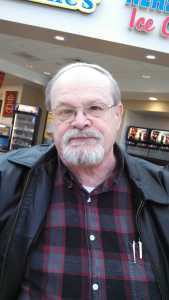
Vaughn C. Hardacker
I recently came across an interesting article on the L&L Blog. It details a writing strategy that I found interesting. The article was written by Kirk McElhearn and was posted on April 16, 2025. The greatest challenge that I face in life is time management. I am such a pantser that it borders on Obsessive Compulsive Disorder. I start doing something, and something else catches my attention, and then it’s “Hello, Rabbit Hole!” and down it I go! In a way, my ability to jump from one project to another has been one of the mainstays of my maintaining a relationship. I have been in two serious relationships in my life, one with Connie, my late wife, and the other with Jane, my current partner. They have one characteristic in common, and they are related to the dreaded Honey-do. I will start doing a task they have asked me to do, and it never fails that as I begin, they find seven other tasks that need doing (aka a rabbit hole), and off I go. I have given them the title of Random Work Generator(along with boss or supervisor). To cut to the chase. Here is the article detailing a time management strategy that I am attempting to follow … wish me luck!
THE L&L BLOG / Scrivener
How the Pomodoro Technique Can Boost Creativity
Kirk McElhearn / 16 April 2025
The Pomodoro Technique is a time-management technique that breaks workdays down into small work and rest periods. For many people, it can boost creativity and productivity.
You know that feeling you get when writing for an hour or two, and you’re starting to lose focus? The words aren’t coming as quickly as you wish, yet you want to push ahead and finish that scene or chapter. When you write like this, you struggle against the inertia that develops as you tire, and your creativity may take the back seat as you strive to reach your goal.
Sometimes you’re in the zone, but you lose that increased energy and creativity if you push too hard. The Pomodoro Technique may help you develop a rhythm for your writing sessions, enhancing your creativity and productivity.
What is the Pomodoro Technique?
In the 1980s, Francesco Cirillo was a university student. He was finding it difficult to maintain concentration despite all the reading he needed to do, and he was looking for a way to study more efficiently. He used a tomato-shaped kitchen timer (pomodoro is Italian for tomato) to structure his study periods, breaking his time into work periods and breaks. He eventually settled on segments of 25 minutes as optimal work periods and five minutes for breaks.
It’s that simple—25 minutes on, five minutes off. Start a timer when you sit down to write; when the timer goes off, take a short break.
Why the Pomodoro Technique works
While this technique isn’t for everyone, there are several reasons why it can work for many people. First, it removes that chasm of despair that writers sometimes face when they sit down to write. Instead of thinking that they’ve got a life sentence in front of a blank page or screen, the awareness that they only have to work for 25 minutes can feel like a reprieve. They don’t feel forced to produce a lot, just enough to finish the session and move on to the next.
The five-minute breaks are not just rewards for completing a session, but also a way to reset the mind, to think about something other than the work, so when you sit back down, your mind is fresh again.
Reducing the long writing work into manageable sessions makes it feel different; your goal isn’t to get to your 80,000-word target, but to get to the end of the next session. And these sessions add up. Many writers find that their word count increases when working like this.
Of course, you still may want to track your word count every writing session, and Scrivener has your back.
How to use the Pomodoro Technique
First, you need a timer. Cirillo used a kitchen timer, and the only disadvantage of his tomato-shaped timer is that, as an analog device, it probably ticked; that would be too distracting for many people. You can buy a digital kitchen timer or use the clock app on your computer, phone, or smartwatch. You can also use the web app on the Pomodoro Technique website.
There are plenty of apps you can buy designed for this technique, but some are overkill, presenting graphs and tables showing how much you work. While they offer a level of rigidity you don’t get with a manual timer, you might prefer the flexibility of taking more flexible breaks. After all, using the bathroom and making a cup of tea can take more than five minutes.
If you follow the technique as designed, here’s your schedule for your first writing session.
During short breaks, you could make tea or coffee, go to the bathroom, or have a quick snack. At the end of the two-hour cycle, you could take a longer break to have a meal, take a short walk, or do something to distance yourself from your writing. You may not return to work after that; you may have errands or other tasks that need completing. But after lunch, you could do another cycle, or even two, depending on your time.
You’ll likely be much more productive during your writing sessions, and when you return to writing after a break, you will not have lost the thread of what you were working on before you paused. Your unconscious mind was probably working while you weren’t.
You don’t have to always adhere to the schedule rigidly. You may be at the end of a chapter or scene, know that you won’t be writing any more that day, and choose to go over by ten or fifteen minutes. This technique is not meant to force you to fit your writing into an inflexible schedule, but rather to help you improve your productivity by not overtaxing your brain and giving it frequent rest periods. It’s easy to keep slogging on when writing, thinking you must hit your daily writing goal. But writing like that makes you less likely to do your best work. We tend to believe the commonplace that “writing is ten percent inspiration and ninety percent perspiration,” but that’s not true for everyone.
The Pomodoro technique isn’t for everyone. You may not think most creatively in 25-minute sessions, and it may take half an hour to get your brain into writing mode. You may find that 25 minutes is too short or too long; we all have different thinking and working styles. Nothing is stopping you from trying other rhythms. For example, you could do 50 minutes of work followed by a 10-minute break each hour. You may also find that longer breaks work better for you, so you can take walks and boost your creativity.
Try the Pomodoro Technique and see if it helps you be more creative. Don’t be afraid to tweak the schedule; find what works best. It might not help you, but it’s worth a try.
Kirk McElhearn is a writer, podcaster, and photographer. He is the author of Take Control of Scrivener and host of the podcast Write Now with Scrivener.
*I want to thank Julia at Literature & Latte – Makers of Scrivener and Scapple <https://www.literatureandlatte.com>> for granting me permission to repost this work.
May 9, 2025
Weekend Update: May 10-11, 2025
 Next week at Maine Crime Writers there will be posts by Vaughn Hardacker (Monday), Gavi Stiteler (Tuesday), Rob Kelley (Thursday) and Matt Cost (Friday).
Next week at Maine Crime Writers there will be posts by Vaughn Hardacker (Monday), Gavi Stiteler (Tuesday), Rob Kelley (Thursday) and Matt Cost (Friday).
In the news department, here’s what’s happening with some of us who blog regularly at Maine Crime Writers:
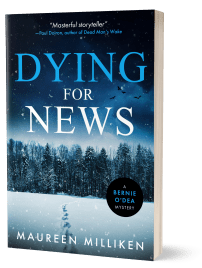 Maureen Milliken is thrilled to announce that DYING FOR NEWS, the fourth book in her Bernadette “Bernie” O’Dea mystery series, is a finalist for a 2025 Maine Literary Award, crime fiction category. The other crime fiction finalists are Paul Doiron (Pitch Dark), Kathryn Lasky (Mortal Radiance) and Thomas E. Ricks (Everyone Knows But You). The winner will be announced at the awards dinner, 7 p.m., Thursday, May 29, at the Next Generation Theatre, 39 Center St., Brewer. For information on tickets (they’re free) or how to attend on Zoom, visit mainewriters.org.
Maureen Milliken is thrilled to announce that DYING FOR NEWS, the fourth book in her Bernadette “Bernie” O’Dea mystery series, is a finalist for a 2025 Maine Literary Award, crime fiction category. The other crime fiction finalists are Paul Doiron (Pitch Dark), Kathryn Lasky (Mortal Radiance) and Thomas E. Ricks (Everyone Knows But You). The winner will be announced at the awards dinner, 7 p.m., Thursday, May 29, at the Next Generation Theatre, 39 Center St., Brewer. For information on tickets (they’re free) or how to attend on Zoom, visit mainewriters.org.
Matt Cost will be doing a COST TALK at the Hartland Public Library in Hartland, Maine, on Thursday, May 15, at 5 p.m. The focus will be on the recently published The Not So Merry Adventures of Max Creed, in which Max Creed is a modern-day Robin Hood striving to bring justice to those abused by the ultra-wealthy. On Saturday, May 17,
Cost, Milliken, and 10 other New England crime writers (including MCW friend Dale Phillips) will be at the MAY IS FOR MURDER book fair at the Bigelow Free Public Library, 54 Walnut St, Clinton, Massachusetts from 10:30 a.m.-12:30 p.m. Saturday, May 17.
Jule Selbo will be at Farmington Library May 15 at 6 p a.m. to talk about her Dee Rommel Mystery series and using Portland as a rich locale for the stories.
May 19, Monday night, she’ll be talking to Maine writers Brock Clarke, Caitlin Shetterly, Bill Roorbach and Muna Shehadi at Portland Stage Theatre in Portland – this will be a look at these writers’ work that touch on the ABSURD (OR ABSURDITY) of RELATIONSHIPS (IS IT LOVE or is it NOT LOVE?) to go along with Portland Stage’s production of Edward Albee’s Who’s Afraid of Virginia Woolf. Portland Stage actors will bring the novelists’ work “to life” in a staged reading format, it will be directed by Todd Backus.
May 21, Jule will be on the SISTERS IN CRIME podcast with Julie Hennrikus at 1 pm. Podcasts (past and present) are posted on the Sisters in Crime website and many Maine Crime Writers have been guests on the show.
Date for this year’s CRIME WAVE, Portland’s crime mystery conference has been set. September 27, Saturday, at the historic Mechanics Hall. A new format one that emphasizes ROUNDTABLES, hosted by authors and others in our field with helpful experience, but with the content driven by the participants’ questions and reflections. Small groups, chance to participate in multiple discussions —something for everyone regardless of subgenre, career stage, approach to or experience with publication. MORE INFO TO COME.
An invitation to readers of this blog: Do you have news relating to Maine, Crime, or Writing? We’d love to hear from you. Just comment below to share.
And a reminder: If your library, school, or organization is looking for a speaker, we are often available to talk about the writing process, research, where we get our ideas, and other mysteries of the business, along with the very popular “Making a Mystery” with audience participation, and “Casting Call: How We Staff Our Mysteries.” We also do programs on Zoom. Contact Kate Flora
The Power of Reading—For Writers

As a writer, I can’t emphasize how important reading is to my process. Aside from my love for books, which was what got me into writing in the first place, reading has always been a way for me to jumpstart my mind, and I’d forgotten about this magical process until just recently.
I’d been in a writing funk this last year, muddling through the myriad of mediocre thoughts and uninspiring sentences, wondering what had afflicted me. Yes, it’s something most every writer struggles with from time to time. And while I was still reading many books, some good and some just not my taste, my conscious mind was not reading with an eye toward writing, but reading merely for the sake of enjoyment, and although there’s nothing wrong with that, there are times when the author must juggle caps to get where he or she wants to go.
Mind you, reading an entire book is an accomplishment of sorts, but writing one is Herculean a task that requires all one’s efforts. Sometimes reading a book is like sledging though a minefield of mud, and this happens even with the best of books. Try getting through Ulysses or Moby Dick. It takes concentration and fortitude, and swatting away all those pesky life annoyances that tend to get in the way, like work, sleep, spouse, movies and television shows, as well as the social media demons that threaten to steal away our attention spans. And so for these reasons, I began to view my reading habits as a chore, and in some cases work.
And it showed in my writing, and in my creative process as a whole, and my mindset began to shift to the point where I didn’t think I could write successfully again.
Then I sloughed off convention and reimagined reading, not viewing it as a chore but as something different. A story that happens in the moment, organically and with time’s arrow. It came as an epiphany that I didn’t need to follow any patterns or rules when it came to reading. Or writing. I returned to the books I loved and read from selected passages, rather than read the whole book, delving into the details of work with unmitigated glee. If I could unshackle the chains of reading, then I could certainly do it with my writing.
So I reimagined the art of writing and freed myself from the constraints of the crime genre. Focused on the moment and the characters needs. It felt liberating and opened up a whole treasure of creative expressions, freeing me from my previous myopic mindset.
And now I’m back writing with more joy than before, pushing scarily into the realms of the unknown, unsure of where I’m heading but at least making progress. We’ll see where my new creativity goes, but it feels good to be back in the game again.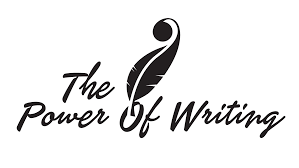
May 8, 2025
Jule’s Eras Tour
Jule Selbo
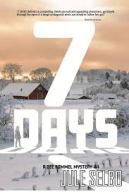
7 DAYS, A Dee Rommel Mystery, was released a month ago. So far I have had a wonderful time doing events at Groveland Library in Massachusetts (what a reading community, headed by librarian Sue Nakanishi – she has such a loyal group of readers). A jolly time at Richmond Library (smaller crowd but amazing questions and great cookies provided by librarian Betsey Noble),an event at Print Bookstore (with crime/mystery writer Matt Cost as interviewer – we had lots of laughs and extra chairs had to be brought out of the closet). I spent a few hours Saturday at LetterPress books on Auburn Street in Portland (a steady and loyal clientele – many were excited to start a new crime-mystery series). And then came Baxter Library in Gorham (thanks librarian Nissa Flanagan and the Friends of the Library who champions these events). Coming up is Scarborough and South Portland and Bangor and almost a dozen more. Add to this several podcasts “appearances” and I am starting to think I’m on the Swift Eras tour.


Hard to tell which one is me, right?
I know authors are supposed to do these events and really, I am glad to be invited/accepted! And (for me) it is fun once I am at the venue – but hours before?
 Yep, those introvert nerves kick in a good six or so hours before and I’m a Linus with a blanket over my head – suddenly agoraphobic and sure all will be a disaster.
Yep, those introvert nerves kick in a good six or so hours before and I’m a Linus with a blanket over my head – suddenly agoraphobic and sure all will be a disaster.
 For writers who set out to communicate/entertain/engage with readers – why is face-to-face one of the harder things we do? As one writer told me – hey think of yourself as a musician who wants his/her album to sell. Well, he/she has to go on TOUR, right?
For writers who set out to communicate/entertain/engage with readers – why is face-to-face one of the harder things we do? As one writer told me – hey think of yourself as a musician who wants his/her album to sell. Well, he/she has to go on TOUR, right?
So that’s what we do – pack up the car with books and get on the road. I heard John Grisham did this in his early writing career. I wanted to check to see if it was true and AI told me it was indeed true!

AI: Yes, in the early days of his writing career, John Grisham did sell copies of his first novel, “A Time to Kill,” from the trunk of his car. After his first book had a few thousand copies printed, Grisham would buy some himself and then sell them to try and increase sales. One account says he even purchased 1,000 copies and sold them from his car.




AI also tells me Stephen King, Jackie Collins, Dean Koontz and even Michael Connelly did “direct sales” at conventions, book clubs or going from bookstore to bookstore to sell their first self-published works.
My Dee Rommel Books have a small publisher – in Texas. When I signed my contract, they assured me their marketing arm was strong. I was naïve then – and believed all I had to do was “the writing”. Well, we all know that’s not true – so thank you all the great venues for being there, introducing the books to readers and supporting writers! And for creating those great posters and email posters and announcements on your websites! Thank you!
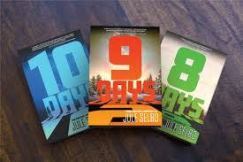
I am so glad that 7 DAYS is out and joining the first three Dee Rommel Books.
PS: This month I wanted to write about ‘creeping sexism’ that is supported by the overuse of “you guys” for male and female groups. But between NOT wanting to leave the condo and LEAVING the condo and taking showers and deciding what to wear and how to make the book events fun for those who show up – I’ll leave that for June.
May 6, 2025
Sara and Dippity Walk the Cliff
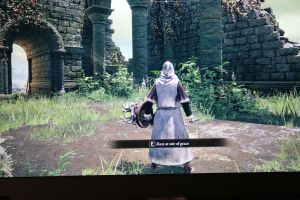
It starts here
John Clark doing something he hasn’t done in several weeks….Write something. It’s one of those long, convoluted, disaster-filled, shaggy dog tales that necessitated my dark and cynical humor coming to the fore.
It’s no secret that I’m several parsecs beyond aghast at what has happened since the November election. I invested a lot of time and money into trying to keep democracy afloat, but the poor pontoons on my ship of state have been sharked, orca’d and narwhalled so viciously that it’s barely afloat.
Add in a mystery ailment that has now inflicted me since early February and remains diagnostically elusive, and you can understand why I hijacked the Grand Funk from the band formed back in 1969. In sum, I’m more husk than substantial, leaving that inner nuclear fusion which drove my writing more resembling a soon to be neutron star.
Flash back again to last October. I won $2000 in a sweepstakes which immediately widened my options for how much I could spend on a new gaming laptop. I used to be a very hard core computer gamer back in the 1990s and have continued off and on over the years. However, my laptop wasn’t powerful enough to handle more complex games like those released recently, hence the want (not need at that point anyhow) for a new monster.
With my affordability point higher, I purchased a new ASUS gamer model with 64 gigabytes of RAM and an eight terrabyte solid state drive. Compared to the HP laptop, it screams. However, I used it but twice before temporarily losing interest in gaming again.
Fate has an even blacker sense of humor than I do. With my hands slowly losing sensation (think taking several tries to turn pages, especially in a newspaper) and growing balance issues (yes I know many have thought me unbalanced for years, but that was in the mental realm), I was beginning to feel funkier than forgotten potatoes in a root cellar.
Then Dame Fortune descended with demented capriciousness while I was playing a new game on the monster after my gaming lust returned. I have an L-shaped computer desk with my work HP laptop above the pull-out keyboard and the ASUS on the other part. I’m a hardcore coffee drinker and despite having spilled coffee on the HP once with the result being only one stuck key, I continued to drink and compute.
This time, the HP got a full bath (it wasn’t on at the time) while I was gaming and that was its demise. I sat there looking at the disaster with detached bemusement before cleaning up the mess and trying to revive it. No luck. My years of computer nerdism have taught me to use external drives for storing files, so I didn’t lose any of my written work or extensive collection of music, but my just purchased albums by Medwyn Goodall and artists on his website were on the HP drive. All my bookmarks were toast as well.
Fortunately, the drive in the HP was a solid state one, so for around twenty bucks, I bought an external case that it fits into and am able to use it as an external drive on the ASUS. That saved the music, but not the bookmarks. In hindsight, it was a mitigated disaster, or as my AA friends would say, an interesting situation, not a problem.

However, that ‘interesting situation sent me full throttle into playing the game that drove my decision to buy a monster gaming machine in the first place. Elden Ring is not only the most addictive game I’ve ever played, it’s also the most challenging and has the biggest world. It’s no exaggeration to say that I die multiple times per gaming session. After getting my first character to level 61, I realized I needed to start over and be more focused on balancing the increases of each attribute. My new character is at level 59 and in replaying to this point, I’m discovering things I missed the first time around. Even at this point, I’ve barely scratched the surface of everything hidden in the unexplored regions.
Perhaps the most seductive aspect of this game is how quickly and easily I can get lost in it and (for several hours at a time) forget the grim reality of 2025.
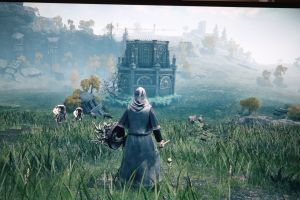
And what constitutes YOUR guilty pleasure?
May 4, 2025
Inspiration Among the Gravestones
In considering what to write about this month I remembered this post from six years ago, ruminating about the places that can trigger story ideas. Like obituaries, cemeteries are full of jumping off points for stories. Do you agree? If so, please share in the comments.
Is it just me, or do all mystery writers feel at home in old cemeteries?
The breeze carries stories of those whose names and dates of death are chiseled into marble headstones, tangible markers of the earthly existence of both the long-lived and those who trod this earth only for a few short years.
Flags denote the final resting place of veterans. Flowers grace the graves of those who are gone but certainly are not forgotten. Elaborate tombs sit across narrow roadways from flat-to-the-earth markers.
A good wander through a burial ground fills me to the brim with ideas.

Old grave marker in the Ventry Burying Ground, County Kerry, Ireland
When we were in Ireland in April, 2017, we spent a lot of time exploring an old cemetery overlooking the sea in the town where my maternal ancestors once lived. There’s a newer section and an old one, the latter pocked with holes dug by rabbits who energetically co-exist with the dead.
It’s a place where you must watch your step lest you find yourself face down atop an old grave.
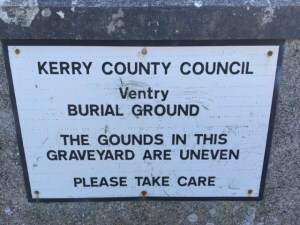
We quickly realized it was important to heed this warning.
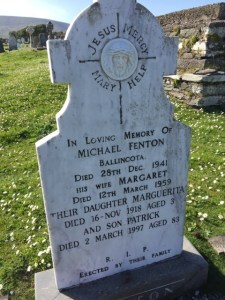
Michael was likely a cousin of my grandmother, from the side of the family that stayed in Ireland when she and her siblings immigrated to the US around the turn of the century.
My grandmother died in this country. She rests next to my grandfather, my parents and other family members in a much more modern cemetery in Massachusetts. I searched the Ventry graveyard unsuccessfully for stones naming her parents, John and Mary (McKenna) Fenton, but was unable to find them. It may well be that their bodies were interred in a private graveyard a mile up the hill in the townland of Baile an Chotaigh (in English, “Ballincota,” as in the adjacent photo), where the family lived for generations.
I did come upon the grave of Michael and Margaret Fenton who would have been rough contemporaries of my grandmother. He was a cousin, I suspect. How sad they lost a daughter at age three. How interesting that their son – year older than little Marguerita – lived to the age of 83.
NOTE: On a return trip to Ireland last spring, I learned from my cousin Muris Fenton that my maternal ancestors are indeed buried in the seaside cemetery, in a plot marked by unengraved head and footstones. Because he’s lived there his entire life he knows a great deal about family history, and was able to show me the exact location. Most of the engraved stones, even in the old part of the graveyard, are relatively new, he said, because generations ago, families could not afford them.
In Portland, we like to walk through Evergreen Cemetery on Stevens Avenue. A National Historic Landmark managed by the City, it covers 239 acres and is known for the “diversity of over 40,000 monuments, including large-scale, distinctive pieces of funerary sculpture of high artistic quality,” according to the City’s website. Evergreen was modeled after Mount Auburn Cemetery in Cambridge, Massachusetts, founded in 1831 as a “rural cemetery and experimental garden.”
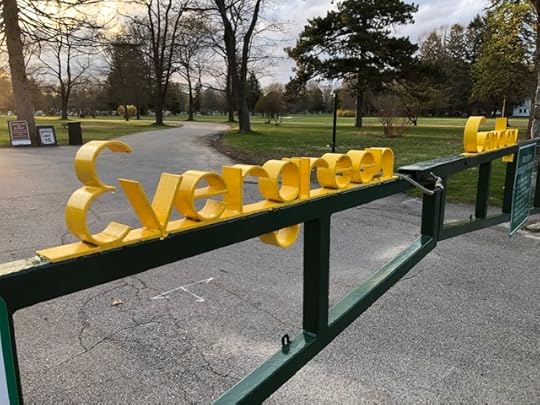
If you’ve never strolled through Evergreen, I recommend a springtime visit to this serene, historic place.
We make early morning visits to Evergreen in early May to witness the warbler migration, which is especially active around the ponds near its back boundary. Maine Audubon leads guided bird walks in this area that are free and open to the public. For more information: https://maineaudubon.coursestorm.com/course/warbler-walks-at-evergreen-cemetery1?page=3
Another historic cemetery we make a point to visit each spring is Laurel Hill in Saco. According to its website, this burial ground was created in 1844 “to replace the town common’s crowded, neglected cemetery.”
Also inspired by Cambridge’s Mount Auburn Cemetery, the architect “included meandering paths and roads, with deciduous trees and evergreen shrubs punctuating broad expanses of open lawn. Situated on the banks of the Saco River, the cemetery’s lawn areas merge with marsh grasses at the river’s edge. A Queen Anne-style chapel built in 1890 remains in use.”

Laurel Hill Cemetery sits on a bluff above the Saco River.
Like many who have no family buried there, we’re drawn to Laurel Hill in May, when the tens of thousands of daffodils planted over the years are in bloom.

Thousands of daffodils are an intentional part of the architectural landscape at Laurel Hill Cemetery.
The search for family history, the bird habitat and the floral burst of spring are secondary, though, to the stories embraced in old cemeteries. Lives are summed up in a few short words, offering writers a thousand ideas on which to ruminate.
Readers: Do you visit cemeteries? When and why? What are your favorites?
May 2, 2025
Weekend Update: May 3-4, 2025
 Next week at Maine Crime Writers there will be posts by Brenda Buchanan (Monday), John Clark (Tuesday), Jule Selbo (Thursday) and Joe Souza (Friday).
Next week at Maine Crime Writers there will be posts by Brenda Buchanan (Monday), John Clark (Tuesday), Jule Selbo (Thursday) and Joe Souza (Friday).
In the news department, here’s what’s happening with some of us who blog regularly at Maine Crime Writers:
Matt Cost recently did an interview with Big Blend Radio on The Not So Merry Adventures of Max Creed. It gives a great overview of the book if you want to check it out HERE.
An invitation to readers of this blog: Do you have news relating to Maine, Crime, or Writing? We’d love to hear from you. Just comment below to share.
And a reminder: If your library, school, or organization is looking for a speaker, we are often available to talk about the writing process, research, where we get our ideas, and other mysteries of the business, along with the very popular “Making a Mystery” with audience participation, and “Casting Call: How We Staff Our Mysteries.” We also do programs on Zoom. Contact Kate Flora
I admit it. I ran away to Holland to see tulips
Kate Flora: The advice one gets, as we age, is “travel while you can.” Of course, we never know when something will strike. But as the sand runs through the hour glass, my husband and I have decided we’d better be doing some of that traveling, and so as you are reading this, I am probably on a train from Amsterdam to Bruges, and then I will travel on to Italy to hike in the hills above the Italian lakes. The Italian lakes, if you haven’t been, are the most romantic place in the world. The hike, however, is a lot of uphill, and as an asthmatic with sciatica, going uphill is not romantic. I will huff and puff and groan but I will do it, probably with the able assistance of my friendly bottle of Advil. (Quick aside: Those yummy Italian wines. Which goes better with Advil, red or white?)
Then I will pick my head up, look at my lovely surroundings, and think: How could I have imagined, growing up on a chicken farm in Union, Maine, that I would ever be here in this amazing, gorgeous place?
I’ve gotten through the packing nightmare of only taking a carry-on for two weeks of cities and hiking. I know I am carrying less makeup than the secretary of defense. Years ago, to calm my anxiety about bringing the right things, my husband told me, “It’s okay. There are these places called stores.” It’s true. There are. Places that are rarely frequented by my kind of shopper. I am absolutely the thrift store queen. If I can’t get it for under thirty dollars, I probably won’t buy it, even if it is a great bargain, or cashmere, or the world’s cutest pair of shoes.
Next time I post, I will share some of pictures. Probably of flowers and lakes and not of me bent over and dusty, making a face that shows how much I’m enjoying toiling up hills. But then I will pick up my head and look around, inhale the beauty, and I will limp on.
Meanwhile, here are some photos from earlier travels:


Rheas in Patagonia
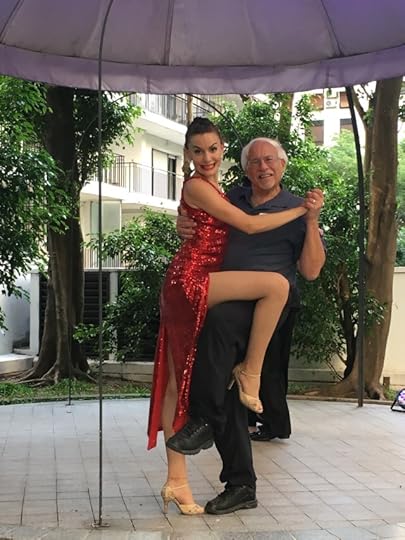
Ken learns the tango in Patagonia
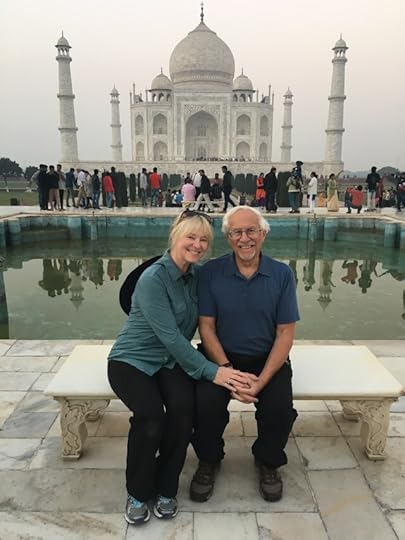
K& K at the Taj Mahal
Lea Wait's Blog
- Lea Wait's profile
- 508 followers



